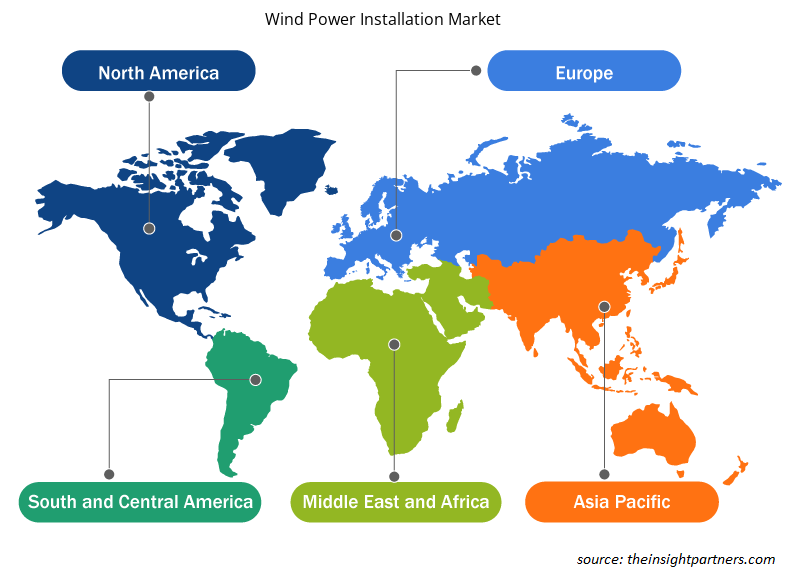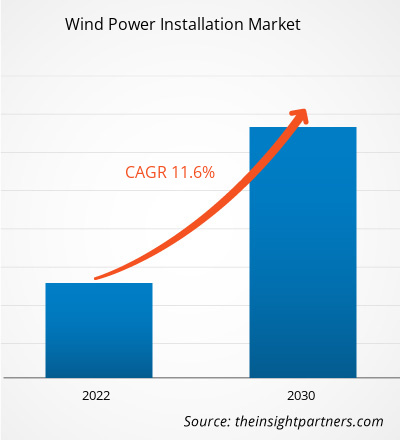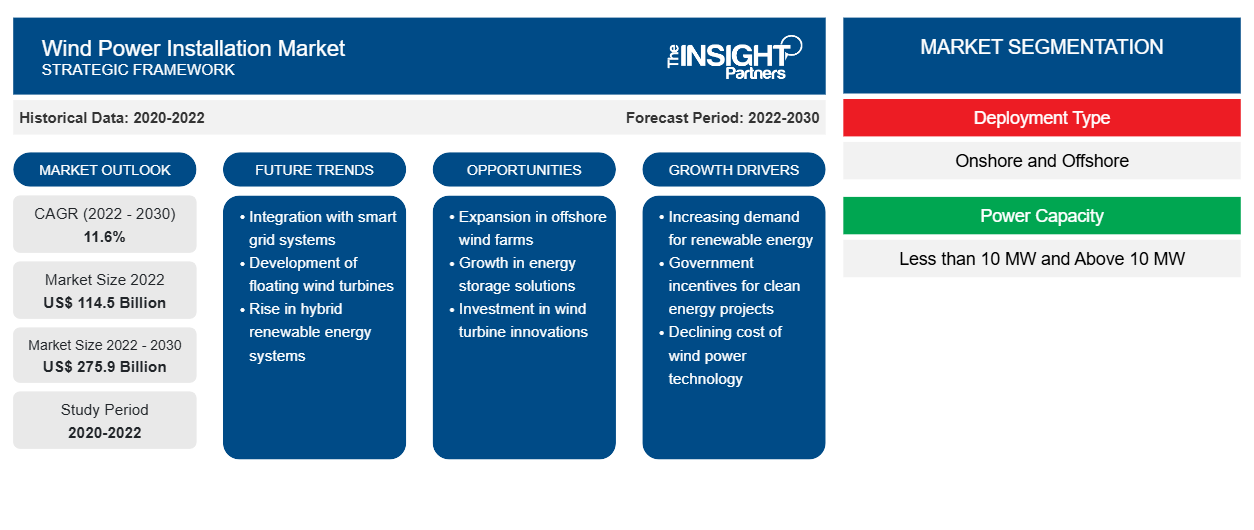[調査レポート] 風力発電設備の市場規模は2022年に1,145億米ドルと評価され、2030年までに2,759億米ドルに達すると予測されており、2022年から2030年の間に11.6%のCAGRで成長すると予想されています。
アナリストの視点:
世界の風力発電設備市場レポートは、北米、ヨーロッパ、アジア太平洋 (APAC)、中東およびアフリカ (MEA)、南米 (SAM) の 5 つの主要地域に分類されています。
アジア太平洋、北米、ヨーロッパなどの地域で陸上および洋上風力発電設備が増加しているため、風力発電設備市場は大幅に成長すると予想されています。再生可能エネルギー産業への投資の増加、工業化と都市化の急激な増加、風力発電容量、新しい電化プロジェクト、および送電網強化イニシアチブは、アジア太平洋地域における世界的な風力発電設備市場の規模の拡大に大きく貢献しています。アジア太平洋地域の風力エネルギー部門は急速に拡大する見込みです。新しい調査によると、国内の洋上風力発電の需要が高いため、2030年までに中国本土が世界最大の市場になるため、この10年間でこの地域の電力容量ミックスのほぼ4分の1を占めると予想されています。
市場概要:
風力エネルギーは、風力タービンを使用して、空気の動きによって生成される運動エネルギーを使用して電気を生成します。風から利用できる電力量は、タービンのサイズとブレードの長さによって異なります。風力発電は、他の再生可能エネルギー技術と比較して、世界中で高いレベルの注目と受容を得ています。風力発電ブレード、タービン、シャフト、およびその他のコンポーネントの設計における技術の新開発は、風力エネルギーの普及と利用可能な風から最適な電力を達成することの大きな進歩に貢献しています。国際再生可能エネルギー機関によると、世界の風力発電の設置容量は、2020年の731,763MWから2021年には824,874MWに増加しました。したがって、風力エネルギーの利点と有利な政策、インセンティブ、および税の払い戻しによる風力発電の設置容量のこのような指数関数的な増加は、市場に有利になると予想されます。
計画中の風力プロジェクトは2024年と2025年までに稼働を開始する予定で、これにより風力発電能力がさらに加速する。スウェーデンエネルギー庁が2022年3月に発表した報告書によると、スウェーデンでは風力発電が2021年の27.4 TWhから2024年までに46.9 TWhに増加すると予測されている。発表された分析によると、スウェーデンは2021年のレベルと比較して2024年までに風力発電を70%以上増加させると予想されている。この取り組みは、ロシアから供給される化石燃料と石油・ガスへの同国の依存を減らすことを目的としている。さらに、ポルトガルの主要公益事業会社EDPとフランス企業Engieの合弁会社であるOcean Windsは、2025年までに洋上風力プロジェクトを開発するために31億5,000万米ドルを投資する計画である。このベンチャーの対等なパートナーは、約7GWの新規容量を生み出すことを目標としている。したがって、このような今後の投資計画は、風力発電設置市場の成長に貢献しています。
米国エネルギー省によると、米国の洋上風力市場は今後10年間で大幅な成長が見込まれています。洋上オークション価格の低下、プロジェクトの水深の増加、タービン容量の増加、均等化発電コストの低下は、市場に利益をもたらすと予想される風力発電設置市場の顕著なトレンドです。COVID-19の影響は、米国、インド、台湾などの市場でのプロジェクト立ち上げの減速に反映されています。COVID-19の再流行にもかかわらず、世界の陸上風力オークション活動は2021年に全体的に順調に進みました。中国は2021年に合計50.6GWの陸上風力発電容量を割り当てることで主導的な役割を果たし、スペイン、インド、南アフリカ、ドイツがそれに続いています。現在の世界情勢は、エネルギー政策、新しい政策イニシアチブ、大規模な投資見通しの流入を示しており、風力設備がネットゼロ排出とエネルギー安全保障の両方の目標を達成する軌道を強めています。
要件に合わせてレポートをカスタマイズする
このレポートの一部、国レベルの分析、Excelデータパックなど、あらゆるレポートを無料でカスタマイズできます。また、スタートアップや大学向けのお得なオファーや割引もご利用いただけます。
- このレポートの主要な市場動向を入手してください。この無料サンプルには、市場動向から見積もりや予測に至るまでのデータ分析が含まれます。
市場の推進要因:
風力発電所の設置を促進する政府の取り組み
風力発電プロジェクトの設置を増やすための政策と投資に関する各国政府の支援は、風力発電設置市場を牽引すると予想されます。インド政府は、加速償却のメリットや風力発電機の特定のコンポーネントに対する優遇関税免除など、さまざまな財政的および金融的インセンティブを提供することで、民間投資を通じて国内の風力発電プロジェクトを促進しています。2022年1月、中国人民銀行(PBOC)は、脱炭素化活動に資金を提供する低コストローンの提供を開始しました。さらに、北京の現在の政策イニシアチブは、低炭素プロジェクト開発者への減税と低金利ローン、電力市場改革、およびグリッドの改善に重点を置いています。カナダでは、オフショア再生可能エネルギー規制(ORER)イニシアチブが、カナダのオフショア地域のオフショア再生可能エネルギー(ORE)プロジェクトと送電線に対する最新の安全および環境保護規制を策定することにより、オフショア再生可能エネルギープロジェクトとオフショア送電線の実装をサポートします。
セグメント分析:
展開タイプに基づいて、風力発電設備市場は陸上と洋上風力発電の展開に分割されています。陸上セグメントは、2022年に風力発電設備市場全体の79.53%を占めました。洋上セグメントは、世界の風力発電設備市場の予測期間中に13.8%の最高の成長率を記録すると予想されています。これは、北米やヨーロッパなどの地域で洋上風力発電設備への投資が増加しているためです。洋上風力技術の採用における成長見通しは、主に技術の進歩、関連する利点、およびさまざまなサービスプロバイダーが提供するターンキーソリューションの増加に起因しています。さまざまな国がクリーンエネルギー目標を達成しているという意識の高まりにより、浮体式洋上風力発電の需要が促進され、風力発電設備市場の成長の潜在的な機会が生まれています。
地域分析:
インサイト・パートナーズの風力発電設置市場分析によると、2022年にはアジア太平洋地域が52.8%という最高の風力発電設置市場シェアを記録し、今後数年間に計画中および進行中の風力発電プロジェクトの追加により、予測期間中に11.1%のCAGRで成長すると予想されています。アジア太平洋諸国は、風力発電による炭素削減目標と国民のエネルギー安全保障に向けた重要な戦略の採用に取り組んでいます。2050年の炭素排出削減目標を達成するために、この地域の多くの国が炭素フリーのエネルギー生成と利用に向けて動いています。インドはアジア太平洋地域の風力発電設置市場で2番目に大きな国であり、2022年には総風力発電設備が1.5GWを超えます。同国におけるクリーンな発電の需要の増加は、今後数年間の風力発電設置市場の成長を促進すると予想されます。さらに、ヨーロッパと北米は、2022年の風力発電設置市場全体のそれぞれ28.5%と11.0%を占める主要地域です。
アジア太平洋地域で再生可能エネルギーが急速に成長しているため、変動性のある再生可能エネルギーを統合し、電力システム全体の信頼性を確保する上で、太陽光発電と風力発電がますます重要な役割を果たすことになります。この地域の多くの発展途上国では、エネルギー貯蔵市場はまだ発展途上ですが、開発の可能性は非常に大きいです。費用対効果が高く柔軟性のある低炭素エネルギー源を最大限に活用し、増大する電力需要を満たすために、風力発電所の設置が拡大すると予想されます。
風力発電設備市場の地域別分析
予測期間を通じて風力発電設備市場に影響を与える地域的な傾向と要因は、Insight Partners のアナリストによって徹底的に説明されています。このセクションでは、北米、ヨーロッパ、アジア太平洋、中東、アフリカ、南米、中米にわたる風力発電設備市場のセグメントと地理についても説明します。

- 風力発電設備市場の地域別データを入手
風力発電設備市場レポートの範囲
| レポート属性 | 詳細 |
|---|---|
| 2022年の市場規模 | 1,145億米ドル |
| 2030年までの市場規模 | 2,759億米ドル |
| 世界のCAGR(2022年 - 2030年) | 11.6% |
| 履歴データ | 2020-2022 |
| 予測期間 | 2022-2030 |
| 対象セグメント | 展開タイプ別
|
| 対象地域と国 | 北米
|
| 市場リーダーと主要企業プロフィール |
|
風力発電設備市場のプレーヤー密度:ビジネスダイナミクスへの影響を理解する
風力発電設備市場は、消費者の嗜好の変化、技術の進歩、製品の利点に対する認識の高まりなどの要因により、エンドユーザーの需要が高まり、急速に成長しています。需要が高まるにつれて、企業は提供を拡大し、消費者のニーズを満たすために革新し、新たなトレンドを活用し、市場の成長をさらに促進しています。
市場プレーヤー密度とは、特定の市場または業界内で活動している企業または会社の分布を指します。これは、特定の市場スペースに、その規模または総市場価値と比較して、どれだけの競合相手 (市場プレーヤー) が存在するかを示します。
風力発電設置市場で事業を展開している主要企業は次のとおりです。
- シーメンス・ガメサ・リニューアブル・エナジーSA
- ゼネラル・エレクトリック
- 三菱重工業
- ヴェスタス風力システム
- センビオンSA
免責事項:上記の企業は、特定の順序でランク付けされていません。

- 風力発電設備市場のトップキープレーヤーの概要を入手
主要プレーヤー分析:
シーメンス・ガメサ・リニューアブル・エナジーSA、ゼネラル・エレクトリック、三菱重工業、ヴェスタス・ウィンド・システムズ、センビオンSA、ウィンド・ワールド・リミテッド、インドウインド、DNV GL、ゴールドウィンド、バーギー・ウィンド・パワーなどが、このレポートで紹介されている主要企業の一部です。世界の風力発電設備市場レポート。
最近の動向:
パートナーシップ、コラボレーション、合併や買収などの無機的および有機的な戦略は、世界の風力発電設備市場の企業によって広く採用されています。主要な風力発電設備市場のプレーヤーによる最近の動向をいくつか以下に示します。
年 | ニュース | 国 |
2022 | ヴェスタスは、PEC Energia と提携して、ブラジルに 86 MW の風力発電所を建設しました。このプロジェクトにより、ヴェスタスは 2018 年以来、ブラジルで 4 MW プラットフォーム風力タービンの受注が 7 GW という節目を超えました。 | 南アメリカ |
2022 | シーメンス・ガメサは、インドの風力産業の促進に重点を置き、96基のタービンを設置するため、Azure Powerと新たな提携を結んだ。 | アジア太平洋 |
- 過去2年間の分析、基準年、CAGRによる予測(7年間)
- PEST分析とSWOT分析
- 市場規模価値/数量 - 世界、地域、国
- 業界と競争環境
- Excel データセット
最新レポート
関連レポート
お客様の声
購入理由
- 情報に基づいた意思決定
- 市場動向の理解
- 競合分析
- 顧客インサイト
- 市場予測
- リスク軽減
- 戦略計画
- 投資の正当性
- 新興市場の特定
- マーケティング戦略の強化
- 業務効率の向上
- 規制動向への対応





















 無料サンプルを入手 - 風力発電設置市場
無料サンプルを入手 - 風力発電設置市場